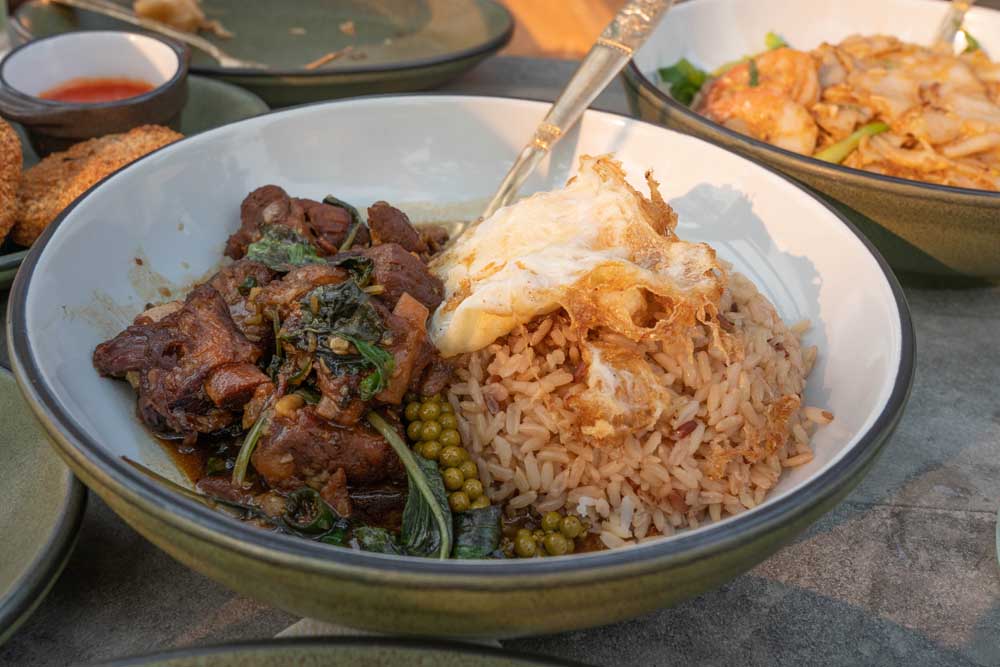Restaurant review: Sen Thai Hot Pot and Noodle House
Published 11:45 am Wednesday, August 18, 2021

- Street food Krapow Moo Thoon is bone-in spare ribs with young green peppercorns and egg over rice.
Bend has several Thai restaurants. The newest addition is Sen Thai Hot Pot and Noodle House, opened by the Itti family, who also own Wild Rose Northern Thai. Like Wild Rose, Sen is not your typical Thai food. But it’s different than its sister restaurant: The dishes are Thai street food, including hot pot noodle soups that you make at the table. But it’s street food in a beautiful setting along Mirror Pond. The success of Wild Rose had Rosie Itti Westlund and her family discussing another location as a spillover from the busy downtown eatery.
After consideration, they decided that they didn’t want a replica of Wild Rose that served family recipes from Northern Thailand.
Itti Westlund explained that there were “mostly street vendors and markets in Thailand, and each side stall specializes in one thing they are really good at. We decided to make those things we like to eat and making the recipes the way we enjoy eating it. It’s taking all those singularly favorite things that Thai people go out and eat every day and then serving it in a restaurant, in Bend, by the river with a great view and a great space that’s a little more bistro-y. Because in Thailand, you are eating in a garage stall. We wanted to keep that vibrancy of that neighborhood restaurant feel. At Sen, it’s very active and loud, and people are talking. It feels more casual but in an upscale environment.”
Thai recipes are based on dishes from China, Japan and India. The influences are apparent when you read the menu and taste the food.
On my first visit, a friend and I opted to sit outside. Reservations are readily available (and recommended) for indoor dining. You must expressly reserve a table for the hot pot noodle soup experience. Outdoor dining is first come, first served.
On both visits, we found the tables were too small. There wasn’t enough room for the shared small plates and entrees that seemed to arrive at the same time.
In Thai, “Tod” means fried. The Poh Pia Sode Tod is like a fried Thai fresh roll. The crispy fried rice paper exterior was flaky. Cutting it into bite-sized pieces revealed that it was wrapped like a sushi roll around a chunk of sweet Chinese sausage, Persian cucumber, and soft tofu marinated in a five-spice sweet sauce. A light egg layer sat below the crispy surface.
It was enhanced by a sweet soy dipping sauce, and sliced jalapenos added a kick.
A mixture of ground-up pork and shrimp is panko-breaded and fried in the Tod Mun Goong. What should have been fluffy meat and seafood cake came to us a bit overcooked and dense. It was like a fried pork chop stuffed with shrimp. The flavors went together well, especially when dipped in the sweet plum sauce and the chili sauce.
We chose a stir-fried noodle dish as one of our entrees. The Guay Teow Mun Goong is made with delicate and slightly sweet wide rice noodles tossed with egg and topped with fresh green onion. Large plump prawns sat atop the noodles that were stir-fried in savory shrimp paste so every bite would have shrimp flavor. Some of the paste had caramelized and tasted like nuts.
While the Krapow Moo Thoon is considered a street food dish, the complexity and dimension of flavors were far from ordinary fast food. Bone-in spare ribs have a subtly sweet sauce. Westerners might notice that the meat isn’t cut in the direction of a single bone.
Instead, bone pieces may be scattered in the meat, as is common in Asian cooking. Itti Westlund explained that in Asian cuisine, it’s common to eat cartilage (and she is often surprised at how much meat is left on the bone here in the U.S.). It may be typical in Thailand, but I felt self-conscious to be picking bone pieces out of my mouth as I ate.
Meat cuts aside, this was an upscale dish. The meat, Thai basil, fresh Thai chili and a fried egg lay atop jasmine rice. Young green peppercorns, still on their stalk, added a bite of pepper when cut off and mixed in with the rest of the ingredients. In all, it was an elegant mix of sweet and spice.
I reserved a hotpot table for my second visit and invited a couple friends. The hotpot is supposed to serve two or three people, but we had plenty for four of us when we added a small plate and noodles.
To create Sen’s popular hot pot experience, they use a butane-fueled camp stove set on the table. There are three hot pot options: the house (meat), seafood and vegan.
The House Hot Pot Set includes a choice of two types of meat (we picked marinated chicken and thin-sliced beef). An instruction sheet tells you when to add each ingredient. Daikon radish, Kabocha squash, corn on the cob pieces, pork meatballs and pork and shrimp meatballs were added first and cooked for about 5 minutes. Next, we broke in the egg and added the chicken and our choice of Woonsen glass noodles. Finally, we added the Chinese greens, Napa cabbage and green onion. At the last minute, we dropped in the thin steak, which cooked quickly.
Sauces “make” the hot pot. While there is a choice of four sauces, try experimenting with each of them.
Sukiyaki sauce may have originally come from Japan, but the Thai version has little in common with its roots. It is a fermented tofu sesame sauce with sweeter chili. “Seafood sauce” is a classic Thai dipping sauce when having boiled seafood, but it complemented the meat as well. It had the flavor of a hot and sour soup with lots of Thai chili, garlic and lime. Jaew sauce is influenced by Indian cooking. This red sauce is a bit spicy and sweet and is often used with grilled meats. It’s made with tamarind, toasted rice and fish sauce with red Thai chilis and green onion.
We were each supplied a little basket tool to scoop out the soup’s ingredients and a ladle for the soup. There’s no right way to eat a hot pot meal. Some scoop and dip the ingredients in the sauce. Others drop the sauce into their soup bowl.
To be sure we had enough food, we tried a couple small plates. The Tuah Gratiem green beans were perfectly cooked with a light coating of oil. It came with a mixture of crunchy fried scallions and garlic that was too salty that night.
The Geow Tod is deep-fried pork wontons. Another Chinese-influenced dish, they are simple, flakey, and flavorful with a sweet plum dipping sauce.
While Pad Thai can often be overpowered with peanut flavor, Sen’s version has a delicate mixture of seasonings, making it smoky, garlicky, with just a hint of peanuts.
The modern dining room hints at a fine dining restaurant, and certainly, the food holds up to that impression. Be prepared for the lively atmosphere, enjoy the fun, and eat outdoors if you want a more intimate experience.
What: Sen Thai Hot Pot and Noodle House
Where: 69 NW Newport Ave., Bend
Hours: 11 a.m. to 2 p.m., 5 p.m. to close, Tuesday-Sunday (Closed Monday)
Contact: senhotpot.com or 541-385-6479






